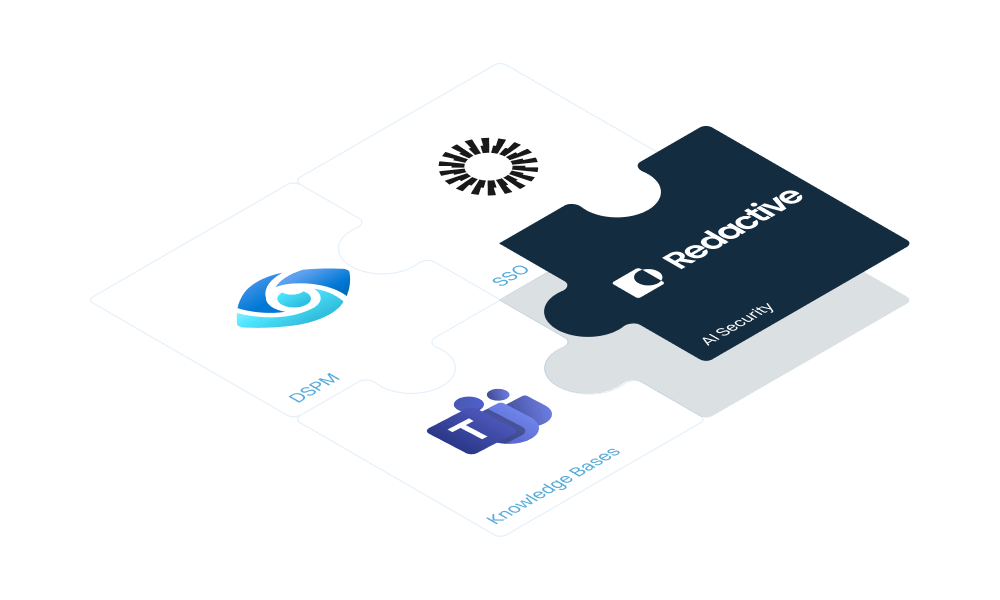AI DATA SECURITY
Understanding AI Data Security
Generative AI fundamentally changes how data access needs to be controlled. AI Data Security allows organizations to safely enable AI access across their data without risking data leaks.

What is AI Data Security?
AI Data Security refers to the technology and practices of ensuring that AI applications, agents -and the employees using them - have an appropriate level of data access in order to significantly reduce the risk of AI-enabled data breaches.
Rather than relying on existing (and often misconfigured) permissions, this approach leverages AI itself to improve data security posture beyond existing rules-based data classification, ensuring data is appropriately secured in anticipation of how AI will access it.
AI Data Security establishes a new standard for enterprise data access and permissioning that is essential in the AI era by leveraging semantic analysis to identify and protect confidential information. While standard system permissions allow organizations to control app-level data access, AI Security offers more precise, granular controls to safely scale AI usage by controlling access at scale, at the document-level.
How AI Data Security Solves Data Access Debt
Table of Contents
- 1What is AI Data Security?
- 2Why Is AI Data Security Becoming So Important?
- 3How AI Data Security Solves the AI Access Control Problem
- 4AI Basics: How AI Accesses, Processes, and Returns Information
- 5How AI Data Security Works: Technical Overview
- 6Where Does AI Data Security Fit Within the Data Security Tech Stack?
- 7Benefits of AI Data Security for Security and Engineering Teams
Why Is AI Data Security Becoming So Important?
AI looks at data differently from humans. Because it can analyze huge data sets -- understanding meaning and returning responses in mere minutes -- it threatens to expose incorrectly permissioned data that was once hidden by obscurity.
It All Starts with Data Access Debt
The messy reality of data permissions for most companies is:
30+ cloud applications
Each application has its own permission model for data access
Document permissions are set by individual users/teams
Security teams lack visibility and control of document-level access
SSO doesn't solve document-level permissions
This creates a compounding data access debt of mismanaged permissions that's becoming increasingly difficult to audit and control across against a sprawling number of systems, groups, and users.
Security teams can't effectively monitor who has access to what data, especially when permissions are inherited or nested across multiple applications and document hierarchies.
How AI Data Security Solves the AI Access Control Problem
AI Data Security -- as a technology and an approach -- solves data access debt to allow organizations to leverage AI without risking data leaks.
Corrects permissions
AI Data Security solutions understand enterprise data at the sentence level, enabling precise control over AI system access and enforcement of employee permissions and data boundaries at a level that wasn't previously possible.
Ensures appropriate access
Prevents unauthorised data access through fine-grained pre-retrieval controls, ensuring AI systems (and their users) can only access and process information they're explicitly permitted to.
Unblocks AI rollouts
Provides the security foundation needed to confidently scale AI implementation across the organization, allowing teams to build and deploy AI applications without compromising on data security or compliance.
Understanding How AI Accesses, Processes, and Returns Information
Before we explore how AI Data Security works, we first need to understand how AI accesses, processes, and returns information. Let's look at a broadly familiar conversational AI use case like a chatbot.
In order to provide informative, context-driven responses, AI chatbots are usually connected to an organization's data sources such as Sharepoint, Google Drive, and Confluence.
Upon a user entering a prompt or question, the AI will then search these knowledge bases for information that appears to satisfy the user's prompt. This information may come from a single data source or document, or it may come from a combination of many, where the AI has been able to understand and collate data from multiple sources to provide a thorough response.
Once the AI is satisfied that it has the information needed to meet the user's needs, the response is generated and delivered to the end user.
How AI Data Security Works: A More Technical Overview
AI Data Security leverages AI's own intelligence to understand both the content and organizational structure of data. Instead of trying to control AI access in retrospect, AI Data Security solutions implement pre-retrieval guardrails by first analyzing the contextual meaning of your data, then identifying anomalous access.
At its core, AI Data Security uses AI to map and understand content, topics, and organizational relationships -- think users, roles, and groups. The system identifies standard patterns in the access permissions of different roles and groups, flagging outliers that could indicate inappropriate access or misconfigured permissions.
Effectively, AI Data Security uses AI's pattern recognition capabilities to strengthen security against AI systems. This creates a dynamic security foundation that:
Ensures existing permissions structures -- such as Role-Based Access Control (RBAC) groups and Access Control Lists (ACL) -- are enforced for AI and human users alike
Continuously analyzes permission structures to ensure they are aligned across different data sources and different access methods. For example, if a user directly accesses a file, or a user asks an AI chatbot or agent about a file.
Continuously analyzes the relationships between data and permissions to ensure data is secured regardless of format. For example, text in a Word document, an email, or a Powerpoint presentation. It can also ensure data is secure based on other factors, such as location. For example, data that's within a specific knowledge base such as Sharepoint, or even a specific folder.
The key difference is that instead of trying to secure AI systems through application-level controls, AI Data Security implements security at the granular level of each individual document or asset by understanding the contextual meaning of the content and applying access permissions accordingly.
This allows companies to segment data sources based on topics, content sensitivity, and group access patterns - creating clear boundaries for AI systems.
AI Data Security helps organizations move forward with AI adoption while maintaining precise control over what information different AI systems can access.
As organizations evolve and adopt more AI applications, these fundamental guardrails ensure consistent data security across the entire infrastructure.

Where does AI Data Security fit within the existing data security tech stack?
AI has exposed a critical gap in most organizations' data security strategies -- widespread misconfigured permissions. AI Data Security addresses this gap, enabling you to leverage the impact of AI without compromising security.
AI Data Security elevates your existing data security capabilities by identifying and correcting access issues at the sentence-, image-, and chunk-level using AI-native analysis to identify access anomalies -- solving a challenge that was previously impossible to solve.
By complementing your current tools and leveraging your existing classifications, AI Data Security gives you visibility into the vulnerabilities that AI will take advantage of.
The Benefits of AI Data Security for Security and Engineering Teams
| Security Teams | Engineering Teams |
|---|---|
| Continuously quantify the live data leaks across the entire enterprise toolchain | Apply true permissions to data within vector stores |
| Understand and resolve the data access risks that AI will exploit, at scale | Secure agents that manage authentication and permission boundaries |
| Democratize data security and empower data owners within the organization to solve access issues | Power AI use cases and agents with permissioned data |
| Automatically remediate threats in real-time | Flexible deployment to meet any compliance or security need |
Related Resources

WHITEPAPER
A Guide to the Emerging AI Security Risks for Enterprises
Learn more about the data security risks posed by Generative AI in enterprise environments.
ARTICLE
Launching Redactive Permissions Assurance
Setting a new standard for how enterprises secure their data in the AI-era.

WHITEPAPER
A Framework for Securing AI for Thousands of Employees
A comprehensive guide to implementing secure AI systems in enterprise environments.



